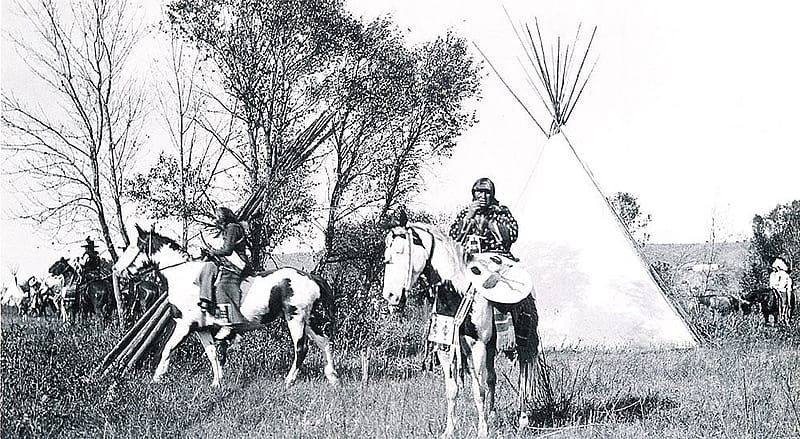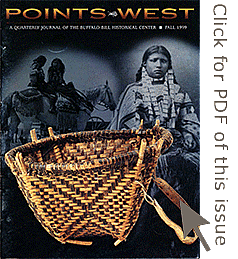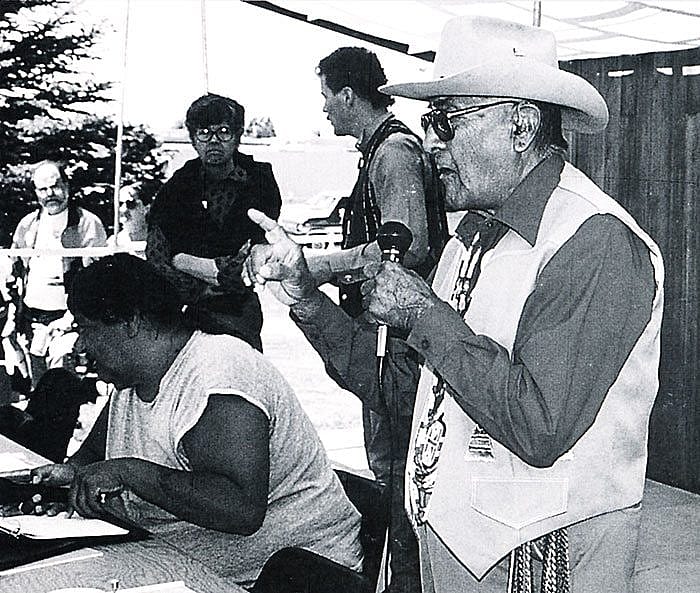
About Crow Indian Horses – Points West Online
Originally published in Points West magazine
Fall 1999
About Crow Indian Horses
By Joseph Medicine Crow
Crow Tribal Historian and Plains Indian Museum Advisory Board Member
Around 1725 or 1770 a Crow Indian war party journeyed to the Fat River (Green River in Wyoming) and either purchased or stole a stallion horse from some other tribe and brought the animal back to the Crow camp in the Upper Wind River of what is now Wyoming.
This was quite an event because the Crows had never seen a horse before. It stood as high as an elk but looked very different, with round hooves, a long shaggy mane and tail, and no horns or antlers. As the people were looking it over, one man got too close to the hind legs of the animal. It quickly kicked him, and the man rolled over into the dirt. After this incident the pals of the man nicknamed him Kicked in the Belly. In time this band of the Crow tribe came to be called Kicked in the Bellies. Today the descendants of these people live near Lodge Grass, Montana, and are still called by that name.

The same people, who live near Lodge Grass, have also been called “People of the Valley of Chieftains” because many great chiefs—such as Spotted Horse, Old Dog, Wolf Lays Down, and Medicine Crow—settled here when the Crow tribe ceded the western part of the reservation and moved to the eastern part in 1884.
About the same time as the Wind River horse incident, another story relates a war party of the Mountain Crow band traveled south and brought back several of the new animals. This party apparently reached the Great Salt Lake.
Yet a third—a highly mythical—version exists. In this story a Crow man saw strange animals in a dream. He set out looking for them and finally saw several emerging from a lake. He captured a few and brought them back to the Crow camp.
The usefulness of the new animal was quickly realized and soon Crow war parties were heading south to bring back more horses. The Crows named this animal Ichilay, which means “to search with,” perhaps referring to the search for enemies and game.
By 1743 when the La Vérendryes of the Hudson Bay Company met a small camp of Crow lndians east of the present town of Hardin, Montana, the Crows already owned many horses and were able to provide the traders with fresh mounts for their return.
Within a short time the Crows acquired large herds of horses by trading with other tribes, by stealing or capturing them from enemies, and by raising their own. Other tribes regarded the Absarokee as rich because they owned so many good horses. While other tribes used the travois to transport their equipment and people, the Crows all rode, from tiny tots to old people, and used packhorses. In this way they could travel fast over any kind of terrain.
The acquisition of the white-man’s horse and firearms soon brought the formerly pedestrian nomads of the Plains into frequent contact and subsequent conflict as they invaded one another’s territory and captured horses. Soon the tribes became more militaristic, and intertribal warfare became a way of life. These tribes developed similar military systems through which boys trained to become warriors and, by fulfilling military requirements, eventually attained the rank of chief. For the Crows, one of the four essential military tests was for a warrior to sneak into an enemy camp in darkness, capture a well-guarded, prized horse, and bring it home.
By the early 1800s, the so-called Plains Indian Culture Area had come into existence, probably one of the last to develop in North America. A culture area is a geographic region inhabited by a number of tribes speaking different languages but sharing enough cultural traits to be classified as representing a distinct style of living.
With the Crow Indians, as with other Plains tribes, the horse quickly became an integral part of tribal culture. The horse has played an especially important role in Crow religion and social and economic life.
Text is excerpted from the book, From the Heart of Crow Country by Joseph Medicine Crow. Copyright 1992 by Joseph Medicine Crow. Reprinted by permission of Orion Books, a division of Crown Publishers, Inc.
Joseph Medicine Crow, noted historian, distinguished elder of the Crow tribe, and Plains Indian Museum Advisory board member, was the keynote speaker at the 23rd annual Plains Indian Museum Seminar in 1999. That year’s seminar focused upon The Horse as Symbol in Plains Indian Culture. Medicine Crow was joined by other distinguished scholars who related the significance of the horse in many aspects of Plains Indian cultures.
Post 034
Written By
Nancy McClure
Nancy now does Grants & Foundations Relations for the Center of the West's Development Department, but was formerly the Content Producer for the Center's Public Relations Department, where her work included writing and updating website content, publicizing events, copy editing, working with images, and producing the e-newsletter Western Wire. Her current job is seeking and applying for funding from government grants and private foundations. In her spare time, Nancy enjoys photography, reading, flower gardening, and playing the flute.











